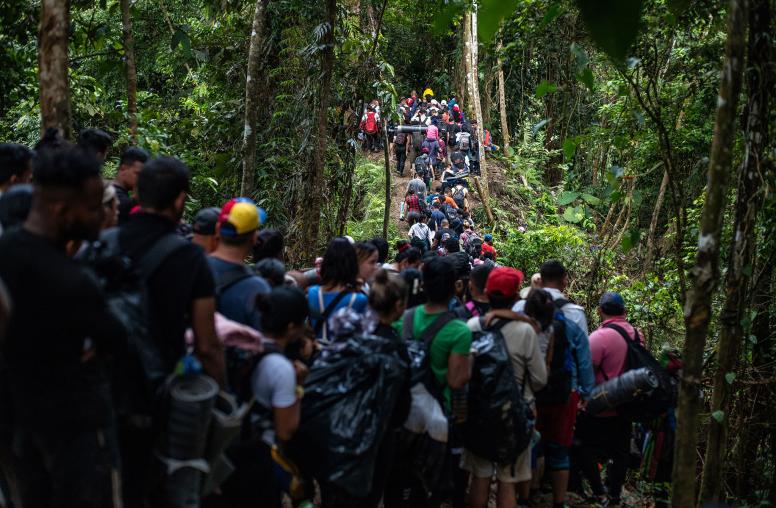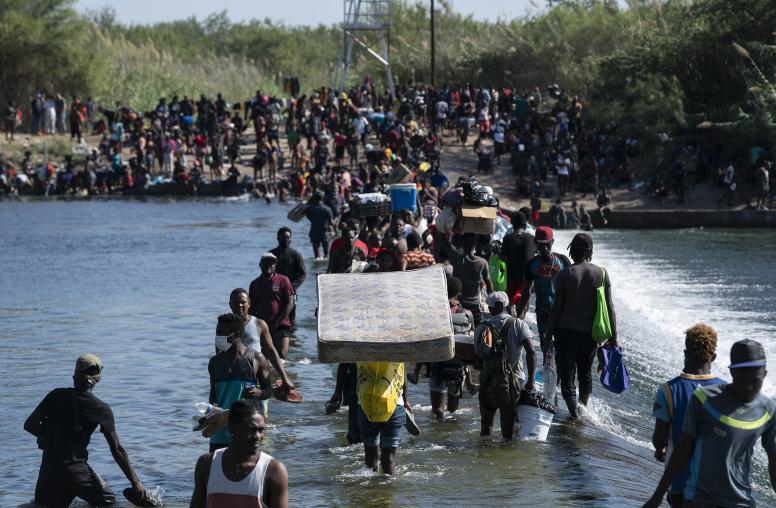America can build peace better—if it includes women.
A new U.S. plan will help fragile states halt violent crises. It should learn from the Women, Peace and Security Act.
The United States is making a publicly little-noted stride this month to strengthen its response to the violent crises worldwide that have uprooted 80 million people, the most ever recorded. Officials are overhauling America’s method for supporting the “fragile” states whose poor governance breeds most of the world’s violent conflict. Yet the proven new approach—helping these countries meet their people’s needs and thus prevent violence and extremism—will fall short if its implementation fails to include and support women in every step of that effort. Fortunately, an earlier reform to U.S. policy offers practical lessons for doing so.

In coming weeks, officials at the State, Defense and Treasury Departments and the U.S. Agency for International Development must present to Congress a 10-year Global Fragility Strategy that will help states build resilience to crises, strengthening their institutions and stabilizing communities torn apart by war. This shift to a preventive strategy is mandated by last year’s Global Fragility Act—a broad reform of U.S. development, humanitarian, and security assistance in conflict-affected countries. It has the potential to reduce the upheavals that have driven a tripling of annual humanitarian aid costs since 2011 to nearly $29 billion this year, even before the added costs of the COVID pandemic.
A truly effective strategy to build better institutions of governance and prevent violence in fragile states will benefit from cross-pollination with the lessons below, drawn from the 2017 Women, Peace and Security Act. This law mandated a government-wide strategy for building peace and security that acknowledges women’s pivotal role and overturns their traditional exclusion from conflict resolution efforts. Indeed, this summer’s writing of the Global Fragility Strategy within executive agencies comes just weeks after those departments submitted new plans to Congress to implement the Women, Peace, and Security Act.
Yet we should not blithely assume that the necessary cross-pollination will happen. These two reforms to U.S. policies emerged from separate, years-long campaigns by distinct groups of scholars, practitioners and other advocates. These groups, both in and out of government, still run the risk of working in separate policy silos. The devotees of countering fragility and those of women’s full engagement in peace and security policies need to seize this opportunity—the shaping of the Global Fragility Strategy and its follow-on planning documents—to jointly apply the three lessons below.
COVID Increases the Urgency
The COVID pandemic only heightens the need to analyze every problem with a “gender lens,” focusing on how women are affected, and how they are vital to solutions. For example, lockdown orders meant to curb the virus have also curbed women’s access to essential health services and led to a spike in domestic violence against women, which the agency UN Women calls the “shadow pandemic.”
New research by the Peace Research Institute of Oslo and the Georgetown Institute for Women, Peace and Security suggests that countries where the status of women is low are less equipped to manage epidemic outbreaks like COVID-19. Applying concrete lessons from the long campaign to include women fully in conflict resolution and peacebuilding is now vital not only to strengthen the Global Fragility Strategy and provide for its longevity, but also to mitigate the “cascading crises”—of disease, poverty and warfare—threatened by the COVID pandemic.
Lesson 1: Make Women’s Participation Meaningful
The Global Fragility Act requires U.S. agencies to consult civil society groups in shaping America’s overall new strategy—and again in drafting the requisite “country plans” for U.S. engagement in at least five priority countries or regions worldwide. To ensure effective plans, these documents need to specify the meaningful (not token) participation of women, throughout the process.
The act recognizes the vital need to shape U.S. development and peacebuilding initiatives in ways that can yield “home-grown solutions” to the deeply political problems of fragile, violence-afflicted states. This requires international aid donors and other actors to accommodate “local ownership” of policies and programs. This means ceding authority to the governments, civil society groups and other entities operating closest to the conflict and amplifying the voices of civil society—especially women and youth—at every stage of the policy design process. Under this model, listening becomes a key action that the international community needs to embrace. Endorsing this approach is simple, but implementing it in a fragile environment or amid conflict is full of challenges.
To prevent civil society consultations from becoming symbolic or ad hoc, policymakers could benefit from the Women, Peace and Security model, shaped in a landmark U.N. Security Council resolution in 2000. A salient element of the model emerged in 2005, when the U.N. promoted National Action Plans on women, peace and security. Currently used in 85 countries, these plans outline an inclusive consultative process with civil society stakeholders, who also help to monitor the government’s progress. Each plan is unique, but most are rooted in the premise that including women in designing policies yields demonstrable dividends. These plans offer a road map for avoiding tokenistic and extractive consultations by recognizing women as equal partners—not solely as information providers—and by allowing them to shape their own agendas in a safe, accessible and empowering environment.
Outside intervenors conceive of local women in a conflict zone almost exclusively as either trainees or “subjects of research,” according to Nobel peace laureate Leymah Gbowee. “What we are looking for … is [programs] beginning to credit women who are at the grassroots level as experts” in the problems at hand, Gbowee said in a recent discussion. To achieve this, outsiders need to build explicit, inclusive listening sessions into their projects. They also might build networks among participants to sustain community engagement beyond the initial consultations.
In applying these gender-inclusive frameworks, the Global Fragility Act’s implementers can build on a proven process for shaping development and peacebuilding programs that bolster local leadership, allocate sufficient resources to local civil society groups and heed the critical insights of women and girls on the front lines of conflict. As U.S. officials select priority countries in which to implement the Global Fragility Strategy, they should prefer those that have developed a National Action Plan for the inclusion of women.
Lesson 2: To Judge Success, Measure Impacts on Women
The Global Fragility Act requires programs and country plans to be carefully monitored and evaluated to ensure that they embrace adaptive learning, experimentation and participation by civil society and local partners. This is one of the act’s most innovative—and most challenging—directives. It establishes a 10-year time horizon for evaluating the extent to which this new foreign assistance model addresses root causes of fragility by creating the conditions for lasting peace. Evaluating this progress means identifying sound metrics for assessing a country’s progression from fragility to stability. The level of gender equality and treatment of women and girls must be key criteria.
Understanding gender dynamics in any country—and especially a fragile country—is paramount to preventing further instability. A solid body of qualitative and quantitative research shows that gender equality is one of the best predictors of state security and stability. Unequal societies are twice as likely to experience internal conflict as states with low fertility rates. And over nearly 20 years of peace processes, women’s participation made peace accords 35 percent more likely to endure at least 15 years. If 50 percent of the population lacks sufficient access to education, affordable healthcare, and jobs, reducing state fragility is an empty mandate. The executive director of UN Women, Phumzile Mlambo-Ngcuka, has compellingly stated: “Choosing to exclude women therefore means that we may be choosing to compromise on our collective desire for lasting peace.”
Projects that aim to reduce fragility in any country need to analyze, from their design stage, the gender inequalities in that society. They must evaluate the hurdles and opportunities in bringing positive change for women—and do so by consulting both women and men early and often. Tools for that analysis are many and varied. USIP’s Gender Inclusive Framework and Theory is a highly adaptable, easy-to-use analytic option with which to understand the context and challenges for women and men, especially in fragile and conflict settings. The United Nations’ Gender Inequality Index tracks the disparity between female and male achievements across three dimensions: reproductive health, empowerment and the labor market. Saferworld’s Gender and Conflict Analysis Toolkit embeds gender indicators directly into a conflict analysis framework. The Peace Research Institute of Oslo and the Georgetown Institute for Women, Peace and Security created the Women, Peace and Security Index, which analyzes trends in women's wellbeing across 11 indicators focused on justice, inclusion and security. When policymakers evaluate the impact of the fragility strategy, they should include measurements from a gender index. Identifying existing gender-sensitive monitoring and evaluation systems in conflict-affected countries, such as those already run by National Action Plans, could help prevent project duplication and save money and resources.
Lesson 3: Train Personnel to Protect Women and Girls
To ensure that humanitarian aid workers and other international peacekeepers do not perpetuate cycles of conflict and fragility, policies should mandate pre-deployment training on gender sensitivity and codes of conduct. One woman in five displaced by violent crises experiences sexual violence. Sometimes, sexual exploitation or violence is committed by military personnel, humanitarian aid workers or peacekeepers against the very people they were sent to help. If ignored or unpunished, the abuse can undermine the legitimacy of peacebuilding efforts and exacerbate drivers of fragility and conflict.
In recent years, the United Nations and international NGOs have stepped up their efforts to tackle this scourge and improve accountability mechanisms. But governments need to do more. The Women, Peace and Security (WPS) Act took up the mantle by mandating gender-sensitive training for all U.S. government personnel deploying to war-torn or conflict-affected locations. U.S. agencies—Defense, State, and Homeland Security Departments and the U.S. Agency for International Development—signaled a commitment to executing this mandate in the strategies they have written for implementing the WPS Act. The plans include training personnel in international human rights law and strategies for protecting civilians from violence and exploitation.
The forthcoming Global Fragility Strategy and its 10-year plans for priority countries present an opportunity to take these efforts to the next level. In these plans, policymakers should build upon the WPS Act’s provisions mandating gender-sensitive training and should learn from their shortcomings, or else risk losing hard-won progress.
The Women, Peace and Security Act has three years of American efforts and 20 years of global application under its belt through U.N. Security Council Resolution 1325. The practical lessons it has uncovered are essential to maximize the impact of America’s improved strategy for delivering foreign assistance in fragile states and ending the violence and destruction bred within them.

